European Exploration and Colonization
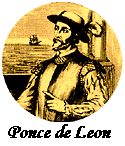 Written records about life in Florida began with the arrival of the Spanish explorer and adventurer Juan Ponce de León in 1513. Sometime between April 2 and April 8, Ponce de León waded ashore on the northeast coast of Florida, possibly near present-day St. Augustine. He called the area la Florida, in honor of Pascua florida ("feast of the flowers"), Spain's Eastertime celebration. Other Europeans may have reached Florida earlier, but no firm evidence of such achievement has been found.
Written records about life in Florida began with the arrival of the Spanish explorer and adventurer Juan Ponce de León in 1513. Sometime between April 2 and April 8, Ponce de León waded ashore on the northeast coast of Florida, possibly near present-day St. Augustine. He called the area la Florida, in honor of Pascua florida ("feast of the flowers"), Spain's Eastertime celebration. Other Europeans may have reached Florida earlier, but no firm evidence of such achievement has been found.
On another voyage in 1521, Ponce de León landed on the southwestern coast of the peninsula, accompanied by two-hundred people, fifty horses, and numerous beasts of burden. His colonization attempt quickly failed because of attacks by native people. However, Ponce de León's activities served to identify Florida as a desirable place for explorers, missionaries, and treasure seekers.
In 1539 Hernando de Soto began another expedition in search of gold and silver, which took him on a long trek through Florida and what is now the southeastern United States. For four years, de Soto's expedition wandered, in hopes of finding the fabled wealth of the Indian people. De Soto and his soldiers camped for five months in the area now known as Tallahassee. De Soto died near the Mississippi River in 1542. Survivors of his expedition eventually reached Mexico.
No great treasure troves awaited the Spanish conquistadores who explored Florida. However, their stories helped inform Europeans about Florida and its relationship to Cuba, Mexico, and Central and South America, from which Spain regularly shipped gold, silver, and other products. Groups of heavily-laden Spanish vessels, called plate fleets, usually sailed up the Gulf Stream through the straits that parallel Florida's Keys. Aware of this route, pirates preyed on the fleets. Hurricanes created additional hazards, sometimes wrecking the ships on the reefs and shoals along Florida's eastern coast.
In 1559 Tristán de Luna y Arellano led another attempt by Europeans to colonize Florida. He established a settlement at Pensacola Bay, but a series of misfortunes caused his efforts to be abandoned after two years.
Spain was not the only European nation that found Florida attractive. In 1562 the French protestant Jean Ribault explored the area. Two years later, fellow Frenchman René Goulaine de Laudonnière established Fort Caroline at the mouth of the St. Johns River, near present-day Jacksonville.
First Spanish Period
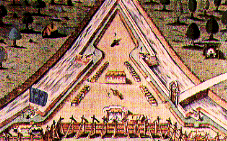
These French adventurers prompted Spain to accelerate her plans for colonization. Pedro Menéndez de Avilés hastened across the Atlantic, his sights set on removing the French and creating a Spanish settlement. Menéndez arrived in 1565 at a place he called San Augustín (St. Augustine) and established the first permanent European settlement in what is now the United States. He accomplished his goal of expelling the French, attacking and killing all settlers except for non-combatants and Frenchmen who professed belief in the Roman Catholic faith. Menéndez captured Fort Caroline and renamed it San Mateo.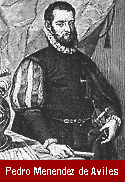
French response came two years later, when Dominique de Gourgues recaptured San Mateo and made the Spanish soldiers stationed there pay with their lives. However, this incident did not halt the Spanish advance. Their pattern of constructing forts and Roman Catholic missions continued. Spanish missions established among native people soon extended across north Florida and as far north along the Atlantic coast as the area that we now call South Carolina.
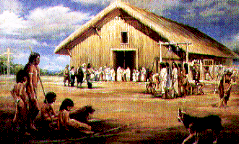 The English, also eager to exploit the wealth of the Americas, increasingly came into conflict with Spain's expanding empire. In 1586 the English captain Sir Francis Drake looted and burned the tiny village of St. Augustine. However, Spanish control of Florida was not diminished.
The English, also eager to exploit the wealth of the Americas, increasingly came into conflict with Spain's expanding empire. In 1586 the English captain Sir Francis Drake looted and burned the tiny village of St. Augustine. However, Spanish control of Florida was not diminished.
In fact, as late as 1600, Spain's power over what is now the southeastern United States was unquestioned. When English settlers came to America, they established their first colonies well to the North–at Jamestown (in the present state of Virginia) in 1607 and Plymouth (in the present state of Massachusetts) in 1620. English colonists wanted to take advantage of the continent's natural resources and gradually pushed the borders of Spanish power southward into present-day southern Georgia. At the same time, French explorers were moving down the Mississippi River valley and eastward along the Gulf Coast.
The English colonists in the Carolina colonies were particularly hostile toward Spain. Led by Colonel James Moore, the Carolinians and their Creek Indian allies attacked Spanish Florida in 1702 and destroyed the town of St. Augustine. However, they could not capture the fort, named Castillo de San Marcos. Two years later, they destroyed the Spanish missions between Tallahassee and St. Augustine, killing many native people and enslaving many others. The French continued to harass Spanish Florida's western border and captured Pensacola in 1719, twenty-one years after the town had been established.
Spain's adversaries moved even closer when England founded Georgia in 1733, its southernmost continental colony. Georgians attacked Florida in 1740, assaulting the Castillo de San Marcos at St. Augustine for almost a month. While the attack was not successful, it did point out the growing weakness of Spanish Florida.
British Florida
Britain gained control of Florida in 1763 in exchange for Havana, Cuba, which the British had captured from Spain during the Seven Years' War (1756–63). Spain evacuated Florida after the exchange, leaving the province virtually empty. At that time, St. Augustine was still a garrison community with fewer than five hundred houses, and Pensacola also was a small military town.
The British had ambitious plans for Florida. First, it was split into two parts: East Florida, with its capital at St. Augustine; and West Florida, with its seat at Pensacola. British surveyors mapped much of the landscape and coastline and tried to develop relations with a group of Indian people who were moving into the area from the North. The British called these people of Creek Indian descent Seminolies, or Seminoles. Britain attempted to attract white settlers by offering land on which to settle and help for those who produced products for export. Given enough time, this plan might have converted Florida into a flourishing colony, but British rule lasted only twenty years.
 The two Floridas remained loyal to Great Britain throughout the War for American Independence (1776–83). However, Spain–participating indirectly in the war as an ally of France–captured Pensacola from the British in 1781. In 1784 it regained control of the rest of Florida as part of the peace treaty that ended the American Revolution.
The two Floridas remained loyal to Great Britain throughout the War for American Independence (1776–83). However, Spain–participating indirectly in the war as an ally of France–captured Pensacola from the British in 1781. In 1784 it regained control of the rest of Florida as part of the peace treaty that ended the American Revolution.
Second Spanish Period
When the British evacuated Florida, Spanish colonists as well as settlers from the newly formed United States came pouring in. Many of the new residents were lured by favorable Spanish terms for acquiring property, called land grants. Others who came were escaped slaves, trying to reach a place where their U.S. masters had no authority and effectively could not reach them. Instead of becoming more Spanish, the two Floridas increasingly became more "American." Finally, after several official and unofficial U.S. military expeditions into the territory, Spain formally ceded Florida to the United States in 1821, according to terms of the Adams-Onís Treaty.
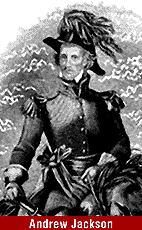 On one of those military operations, in 1818, General Andrew Jackson made a foray into Florida. Jackson's battles with Florida's Indian people later would be called the First Seminole War.
On one of those military operations, in 1818, General Andrew Jackson made a foray into Florida. Jackson's battles with Florida's Indian people later would be called the First Seminole War.
